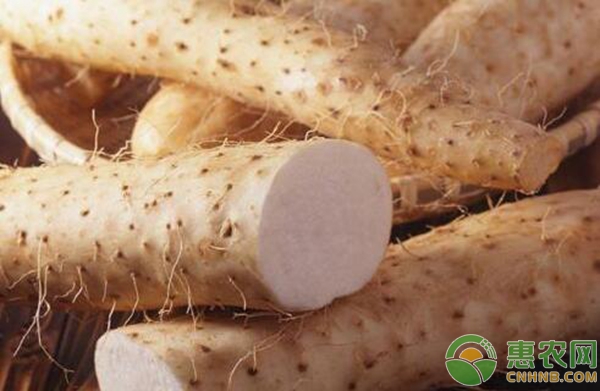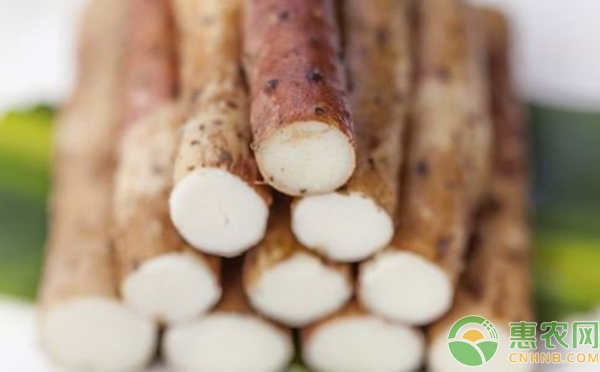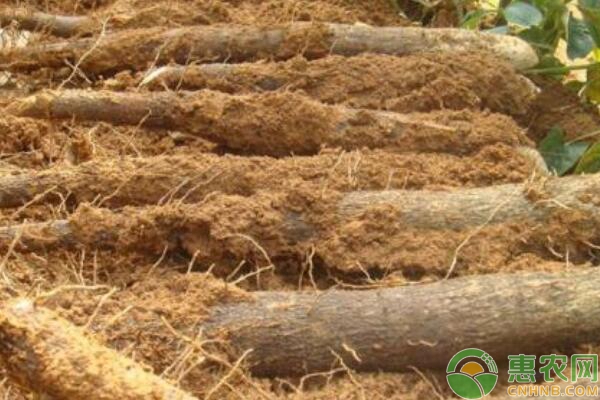Long yam is also called yam and yam. It is a nourishing food that can nourish the stomach and strengthen the spleen. Many growers have expressed doubts about the cultivation of yam. The following series of Huinong.com will tell you about the technical regulations for the pollution-free cultivation of the yam of Zhoukou Mayor.

1 Scope of application
This standard specifies the production environment, cultivation techniques, pest control, harvesting, storage and production archives of pollution-free long yam production. This standard is suitable for the production of pollution-free long yam in Zhoukou City.
2 Normative references
The following documents are indispensable for the application of this document. For undated references, the latest edition applies to this document. "Safety Standards for the Use of Pesticides" (GB 4285), "Guidelines for the Rational Use of Pesticides" (GB/T 8321), "General Principles for the Rational Use of Fertilizers" (NY/T 496), "Organic Fertilizers" (NY 525), "No Pollution Environmental Conditions for Producing Vegetable Producing Areas (NY 5010).
3 Terms and definitions
The following terms and definitions are appropriate for this document.
3.1 Zero remainder
The aerial tuber, which is produced between the yam and the vine leaves, is a seed that can be used as a seed to regenerate the yam plant.
3.2 Yam plant
The upper end of the yam tuber is thin, with buds and stalks, usually used for planting, called yam or yam mouth.
3.3 Yam section
The edible part of the lower part of the yam tuber contains the dormant buds. When the plant is insufficient, it is cut into small pieces and is called the yam section.
4 Production base environmental conditions
4.1 Natural resources
The long yam production area requires good lighting conditions and abundant light and heat resources. The annual average temperature is above 12 °C, the effective accumulated temperature is ≥10 °C, 4 300 °C, the frost-free period is ≥200 d; the average annual sunshine hours are over 2 200 h.
4.2 Soil conditions
The yam is a deep-rooted crop, which is light sandy loam. It requires deep soil layers, generally more than 1.5 m deep (including no clay interlayers with a thickness of more than 15 cm). The soil is loose and the terrain is flat (the middle part of the plot is slightly higher and the circumference is slightly lower) ). The soil is more fertile, containing 1.5%~1.8% of organic matter, 0.08%~0.10% of total nitrogen, 60~80 mg/kg of available nitrogen, 20~30 mg/kg of available phosphorus, 150~200 mg/kg of available potassium, pH value 6 ~8.

4.3 Irrigation conditions
The irrigation water is mainly well irrigation, the groundwater quality is good, the surface water depth of the groundwater source is greater than 15 m, and the water quality indicators meet the farmland irrigation water quality standards.
4.4 Surrounding environment
The plot is far away from the main road 200 m away, and there is no pollution source around it; there are high-standard ponds, ditches and canals around it to facilitate the leakage of water.
4.5 Foreground crops
The former carp is a grass crop such as wheat and corn.
5 Cultivation techniques
5.1 Selection of varieties
Jiuxianhuang is a high-yield, high-yield, disease-resistant, adaptable, and commercial yam variety selected from long yam. The characteristics are that there are no knots or few knots. Generally, the length of the tuber is 1.0~1.5 m and the thickness is 5~10 cm. The weight of the tuber is about 2.5 kg, the weight is 8~10 kg, and the yield of fresh yam is 75~90 t/hm2. Winding stems, right-handed, stems are about 4 m long, the shape of the leaves is thin, the tubers are thin and thin, smooth and less tumorous, with more white meat, and the upper part is crispy and dry, easy to peel and process. It is cultivated in the upper part of the ground, and is planted in the lower part of the ditch. The density is about 42,000 plants/hm2. It is planted in the middle and middle of April, and harvested in the middle and early October. It has the characteristics of high input, high yield and high efficiency.
5.2 Preparation of reproductive material
5.2.1 Yam plant. The yam plant should have the characteristics of short stems and thick stems, full heads, no disease and no spots, and no damage to the epidermis. When planing yam from the beginning of autumn and winter, cut the plant, cut into pieces of 25~30 cm in length and weigh 200~300 g, then use 70% mancozeb wettable powder to cut into the sun and let it dry in the sun or Dry in the indoor ventilation for 7~10 days, so that the wound is healed and stored in a warm place indoors. When the indoor temperature is lower than 0 °C, it is necessary to cover the grass and other things to prevent freezing. It will be taken out in late March of the next year, and it can be planted after being finished drying.
5.2.2 Yam section. When the yam plant is insufficient, the yam segment can be used instead. About 30 days before planting, when the weather is fine, choose the yam tuber with a diameter of 2~4 cm, light and clean color, less roots, thin hair, no pests and diseases, no rot plaque, uniform thickness and uniformity. Use bamboo sticks or nails to cut into yam sections (the bottom of yam sticks is not easy to seed), leaving at least one dormant bud, about 20 cm in length, each section weighing 250-300 g, and the section 蘸 70% mancozeb wettability Powder, and marked with a brush and ink on the top of the potato. Put the cut pieces in the sun to sown, and lay the grass under the blankets. The potato pieces are arranged in a layer, and often flipped to keep the seeds evenly distributed. Generally, they are dried for about 10 days, and the potato pieces are indented and cracked. The general seed preparation is 7 500~9 750 kg/hm2.
5.2.3 Soaking seeds. Before sowing, the seeded potato will be soaked with 70% carbendazim WP 1 000 times for about 5 minutes, and then dried and dried. Planting with yam section, the emergence of seedlings is about 10 days later than the yam planting. Therefore, the immersed yam section can be buried in sand with a humidity of about 20% before planting, and the temperature is kept at 25 °C for germination. When the bud length is 1.0~2.5 cm, the temperature drops to 15~18 °C, and the seedlings are planted 5~7 days later [1].
5.3 Fertilization and soil preparation
Apply enough base fertilizer, generally apply fully decomposed organic fertilizer 45~60 t/hm2, bean cake fertilizer 750 kg/hm2, 51% potassium sulfate compound fertilizer (17-17-17) 1500~1 800 kg/hm2, after application Deep plowing 25~30 cm, then flattening. Before the land preparation, use 3% phoxim granules 30~45 kg/hm2 to control underground pests. In a flat field, use lime to scribe 1 m line spacing, and use a self-propelled yam trencher to ditch along the line. The length of the auger bit is 1.75 m and the diameter is 20 cm. After the operation, a ripper belt with a ridge height of 20 to 25 cm and a ridge width of 50 to 60 cm is formed. If the seeding period is not reached, the top and sides can be flattened.

5.4 Seeding
1 year planting 1 茬, spring harvest autumn harvest. Planting yam should not be repeated as much as possible. If it is heavy, it needs to be planted in the second year. When the soil temperature of 5 cm is stable and passes through 10 °C and tends to be stable, it can be sown. Generally, before and after the "Guyu" solar terms, the time is around April 20. On the plane of the ridge, the planting ditch with a width of 10 cm and a height of 10 cm was dug against the deep trench, and the bottom of the ditch was lightly stepped on the foot. Place the upper end of the yam plant or the yam section of the buds in the same direction at 25~30 cm. The plant spacing is placed at the bottom of the ditch and planted in a single row. The yam plant and the yam segment are separately planted. After sowing, use 70% carbendazim WP 1 000 times liquid sowing seed ditch spray, dry and cover soil 8~10 cm thick, shoot the real 墒 [2]. According to the requirement of line spacing of 1 m and plant spacing of 25~30 cm, the seeding density was 37,500 to 42,000 plants/hm2.
5.5 Field Management
5.5.1 Thinning. Under the condition of soil water content of 18%~20% and ground temperature of 10~15 °C, the yam planting after sowing was about 20 days, and the yam section was about 30 days. When the seedlings are found to have multiple stems, the method can be carried out by hard pressing, using one hand to hold the soil on the base of the yam seedlings, and the other hand to gently remove the excess stems, leaving only one strong owner per plant. Stems.
5.5.2 Racking the vines. When the main seedling height is about 30 cm, the frame is used, and the frame material is 150~170 cm. The old frame material needs to be immersed and disinfected with 70% carbendazim WP 1 000 times. Two trenches, six racks form a "four-cornered frame", the lower end is inserted into the soil 20 cm, the upper end is 30 cm, and is tied together with a rope. The frame is connected with the frame by a crossbar to ensure firmness. If the frame is too late and the stems are too long, the stems can be artificially supported on the support [3].
5.5.3 Topdressing. From the end of June to the beginning of July, the application of 45% potassium sulfate compound fertilizer (15-15-15) 225~300 kg/hm2, the method of topdressing is to first open a small ditch in the middle of the two ridges, apply the fertilizer, and then cover the soil. . The second fertilization time was around August 10, and the amount of fertilizer applied was 300 kg/hm2.
5.5.4 Irrigation and drainage. The yam is about 10 days after emergence, that is, from late May to the end of June, the seedlings are in the early stage of leaf placement, and can be lightly watered by means of sprinkling or drip irrigation. In the late growth stage of stems and leaves, the soil is kept dry and wet, and the tubers are properly watered during the expansion period to keep the soil moist. Stop watering 15 days before harvest. In the rainy season, it is necessary to pay attention to timely drainage, and prevent rainwater from flowing over the surface to cause collapse and rotting roots. In addition to stepping on the base of the ridge during the preparation of the ground, the drainage ditch can be dug in the middle of the 2 rows, and a groove can be excavated every 50 m in the field. In the case of heavy rain, the water can be directly discharged from the field to the waist. The ditch is discharged from the field by the lumbar groove.
5.5.5 Weeding. After the seedlings are unearthed, they should be weeded in a timely manner. After watering and raining, they should be ploughed and soiled.
6 pest control
6.1 Principles of Prevention
In accordance with the plant protection policy of “prevention first, comprehensive preventionâ€, we adhere to the principle of harmless treatment based on “agricultural prevention and control, physical prevention and control, supplemented by chemical prevention and controlâ€. Focusing on prevention and control during sowing period, strengthening soil treatment and seed potato disinfection measures, comprehensive application of pesticides during the growing season, and playing various functions such as disease prevention, pest control, fertilizer supplementation and regulation.
6.2 Prevention methods
6.2.1 Agricultural control. With grass crops for more than 3 years of rotation; deep tillage; deep application of decomposed organic fertilizer, rational allocation of phosphorus, potassium fertilizer; clean pastoral; elevated cultivation; use disease-free seed potatoes.
6.2.2 Physical control. Use insecticidal lamps and attractants to trap night moths and underground insects.
6.2.3 Chemical control and chemical control. Chemical control and chemical regulation drugs should focus on high efficiency, low toxicity, low residue, and multiple pesticides alternately used. It is forbidden to use high-toxic and high-residue pesticides that are prohibited by the state. 1 Yam leaves. In the initial stage of leaf placement (generally from the end of May to the beginning of June), the roots are irrigated with 3% nail cream, carbaryl WP 1, 000 times solution and rooting seedlings 1 000 times to prevent soil-borne diseases and promote rooting; % Krabi salt dispersing granules 2 000 times liquid + 70% mancozeb WP 1200 times liquid leaf spray to prevent larvae and brown spot disease. 2 The growth period of the leaves of the yam is high. In late June or about 55 days after emergence of yam, spray 10% of Vitalin 500 times solution + 0.4% potassium dihydrogen phosphate solution + 80% chlorothalonil WP 500 times to control the length of yam mouth, prevent Spot blight, blight, anthrax. 3 yam rhizome expansion period. On July 25th, spray 10% Vitalin 300~500 times liquid + 70% methyl thiophanate WP 1000 times liquid + 0.01% brassinolide solution 1500 times solution to promote tuber swelling. Prevention of anthrax. At the beginning of August, spray 10% Vitalin 500 times solution + 0.01% Brassinolide solution 1500 times solution + 32.5% benzene azoxystrobin suspension 2 000 times solution; after 15 days, use 18% chlorine Bile naphthalene acetic acid wettable powder 500 times liquid + 30% pentazole · prochloraz WP 2 000 times liquid spray; into September, can spray Hui Manfeng, potassium dihydrogen phosphate or amino acid and trace element foliar fertilizer To prevent premature aging of the leaves.
7 harvest
7.1 Harvest period
In late October, before and after the frost, the aerial part of the yam can be harvested completely withered. Specific harvest dates can also be determined based on market demand. The stems and leaves are cleaned up and transported out of the field to concentrate the manure, and the shelves are bundled and stored [4].
7.2 Harvesting method
At one end of the yam ditch, digging a ditch 1 m deep and 20 cm wide, use a yam shovel to shovel the surrounding soil, and gently remove the whole yam by hand. Prevent mechanical damage during mining.
8 storage
8.1 Packing
Remove the dirt, fold the upper mouth and store it for planting. The rest will be packed and sold according to the standards and specifications such as thickness, length and color.
8.2 Storage
The yam that is prepared for storage requires no disease spots, no insect marks, and no wounds. Generally, it is piled up indoors. The bottom layer is covered with crop straw, a layer of yam and a layer of sand. The pile height is 1.0~1.5 m. The upper part is covered with grass felt. The storage temperature is 2~4 °C, and the relative humidity is 80%~85%.
9 Production file establishment
Establish production technical files, record the relevant content of yam production environment, management measures, pest control and harvesting, and keep the production archives for 2 years.
Thermal Insulation Net,High Efficiency Aluminum Foil,Indoor Insulation Sunshade Net,Indoor Woven Shade Net
Changzhou Green Nets Co.,Ltd. , https://www.czglnets.com